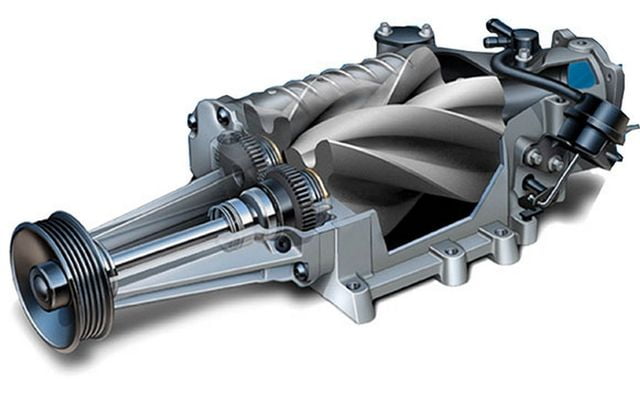We are back with an interesting theme from Automobile Engineering which will be of relevance to a lot of people. We have always heard the terms Turbocharging and Supercharging. These are essentially the forced induction techniques that allow more air to entire the engine in order to generate more power and torque. As usual, we will try to explain this complex topic in a simple and easy-to-understand manner. If you want to keep yourself updated with the latest news from the world of the automobile industry, make sure to follow Car Blog India. If you are interested in learning about various technologies from automobile engineering in simple language, make sure to check out the Automobile Technology Section on the website.

What Are Superchargers?
People have been wanting to make more power and torque in their vehicles since time immemorial. No matter how much power and torque the cars come with, people have this habit of wanting more performance. In a bid to do this, most of the modern cars already come with some form of forced induction. This could be turbocharging in most cases. However, there are some carmakers who also equip their cars with Superchargers. Superchargers are air compressors that can compress the air, increase its pressure which allows the engine to take in more air. This is because compressed air has less volume. Once the engine receives more air, more fuel can be injected into the engine as well. The result of this will be a bump in the power and torque outputs of the vehicle. Superchargers can be retrofitted in your cars by the automotive performance enhancement companies as well. They offer a complete kit for installing a new supercharger in your car along with all the necessary components.
Also read: Steering Mechanism – Hydraulic, Electric, Electrohydraulic Power Steering!
Superchargers vs Turbochargers
The difference between a turbocharger and a supercharger lies in the way they get the power to operate. While the turbochargers use the exhaust gas mass to spool the turbine, which in turn rotates the compressor, the supercharger is driven by the engine power. It is connected to the crankshaft of the engine via a pulley and drives the compressor of the supercharger. This enables an instantaneous response even at low engine RPMs because the compressor does not have to wait for large amounts of exhaust gases to spool up. Therefore, the low-end response is greatly enhanced by the use of a supercharger. However, the speed of the compressor is constant and it remains so even during the mid and high engine RPMs as well. This is called a positive displacement supercharger. The lack of a turbo lag and the engine driving the compressor are two of the main differences between turbochargers and superchargers. Let us discuss the types of superchargers available in the market.
Also read: What is EGR (Exhaust Gas Recirculation) – Working and Advantages!
Roots Supercharger
The most popular type of supercharger used in most vehicles is the Roots Type Supercharger. A Roots Supercharger consists of two identical rotors which guide the intake air and makes it possible to accommodate more air into the cylinder of the engine. Essentially, these are mounted directly on top of the intake manifold and driven by the power from the engine. These do not compress the air but seals the air to not let it go back to the atmosphere and therefore use sealant materials. The rotors are constantly in contact with the supercharger housing and therefore, require a bit more care and maintenance at regular intervals compared to the other types of superchargers. Traditionally, the rotors were made up of 3 lobes but the modern rotors use 4 lobes which improves the overall efficiency of the supercharger. Modern-day roots superchargers also have by-pass valves to make sure that the superchargers are not working constantly even when the additional power is not required. This affects efficiency in a positive way. The downside to one of such superchargers is the size and packing in the engine.
Also read: What is Air Suspension – Uses of Stiff and Soft Springs!
Twin-Screw Superchargers
The twin-screw supercharger makes use of two rotors of different shapes which mesh the air between the rotors. Hence, the air is actually compressed within the supercharger itself. Then, the air goes through the intercooler and pushed into the cylinder. The difference from the roots supercharger is that the air is compressed with the supercharger. The by-pass valve is extremely important in the twin-screw superchargers because there is constant compression of air taking place at all times. This is not required while normal cruising or city driving conditions and therefore is inefficient. Like the roots superchargers, the main issue with the twin-screw supercharger is also packaging and location. They must be mounted on top of the engines directly to be effective and driven by the pulley which is connected to the crankshaft of the vehicle. The superchargers make power across the entire RPM range of the engine although they need the power to do that from the engine itself.
Also read: What is Engine Braking – How Cooling System works?
Centrifugal Superchargers
The centrifugal superchargers are similar, in construction, to the turbochargers. There is a turbine and compressor assembly which is connected to the engine. The major difference between the centrifugal supercharger and roots or twin-screw superchargers is that the space needed to install is lesser. The centrifugal supercharger is a compact component and the space needed to place the supercharger in the engine is not large. This also ensures that not a lot of weight is added to the engine. The output of the centrifugal supercharger is different than the roots or twin-screw superchargers. The torque curve is like that of the turbocharger. There is a turbo lag at low engine RPMs when the turbine has not yet spooled enough and at higher RPMs, the compression is higher. When an electric motor is attached to the vehicle with the help of a 48V hybrid system, the power used to drive the centrifugal supercharger comes from the motor instead of the engine. The engine supplies the power to an alternator which powers the battery which in turn powers the electric motor. The electric motor drives the supercharger to pull in more air and generate more power and torque.
Also read: What are Catalytic Converters – How does they reduce emissions?
Image Source: Car Throttle


